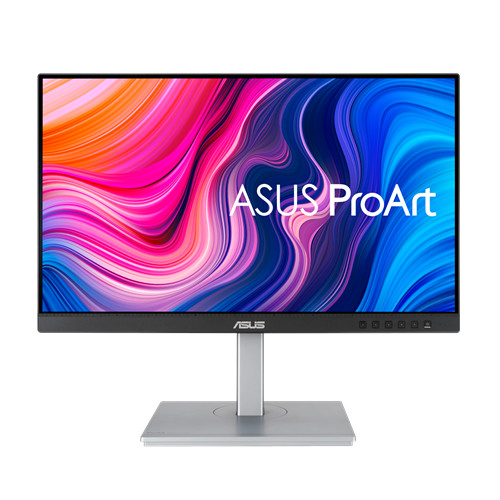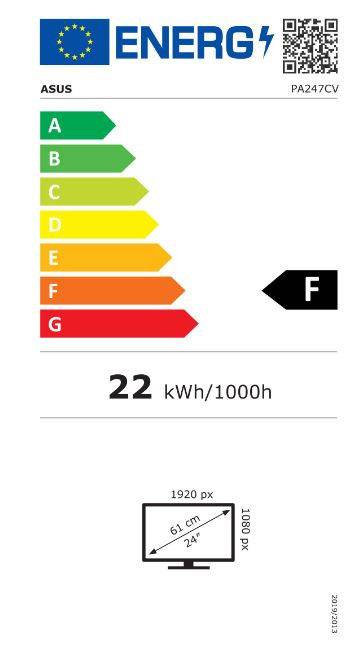



















£236.73*
- Resolution 1920 x 1080 Full HD
- Diagonal 24"
- Panel type IPS
- Refresh Rate 75Hz



Product information
ASUS ProArt Display PA247CV Professional Monitor - 60.5cm (23.8 inch), IPS, Full HD (1920x1080), 100% sRGB, 100% Rec. 709, colour accuracy ΔE < 2, Calman-verified, USB-C, DisplayPort daisy-chaining, ProArt Preset, ProArt Palette, ergonomic stand
- 60.5cm (23.8 inch) Full HD (1920x1080), IPS display with LED backlight and wide viewing angle of 178°
- International colour standard with wide colour gamut coverage of 100% sRGB and 100% Rec. 709
- Calman verification with factory pre-calibrated settings for excellent colour accuracy Delta E < 2
- Comprehensive connectivity options, including DP over USB-C™ with 65W Power Delivery, DisplayPort, HDMI and a USB hub
- 75Hz refresh rate and Adaptive Sync technology (48~75Hz) for animated content with fast action and to prevent tearing
- Using the DisplayPort interface, up to four monitors can be daisy-chained and used simultaneously
- Ergonomic design with 130mm height adjustment as well as 90° swivel, +35° ~ -5° tilt and 90° pivot function for comfortable use
The ProArt Display PA247CV is a 60.45cm (23.8 inch) monitor designed to meet the needs of creative professionals, from photo and video editing to graphic design. The ProArt Display PA247CV is factory pre-calibrated and Calman-verified to ensure excellent colour accuracy (Delta E < 2). Additionally, it supports the industry standard of 100% sRGB / 100% Rec. 709 colour space coverage. The integrated USB-C port supports data transfers, DisplayPort and Power Delivery with 65W via a single cable. This provides a convenient all-in-one solution and keeps your desk tidy. With the PA247CV, you can achieve exactly the look you want quickly, easily and precisely.
High colour fidelity for extremely expressive shades
Thanks to the precise and lifelike colour reproduction, the user experiences particularly pure, expressive colour shades. The ProArt achieves a Delta E of < 2, so your images are accurately represented on screen and you can see exactly how your work will look in the end.
Real colours, straight from the factory
Creative professionals rely on colour-accurate displays to ensure their work looks exactly as intended. The ProArt Display PA247CV is pre-calibrated and Calman-verified at the factory to ensure industry-leading Delta E <2 colour accuracy Every ProArt display undergoes rigorous and extremely precise testing to ensure more consistent colour gradations. As a professional user, you can rely on the highest level of colour accuracy for content playback and creation.
Quick colour adjustment
The ASUS-exclusive ProArt Preset feature offers multiple modes to quickly adjust the colour space. Whether you're making colour corrections, editing videos or editing photos, you can easily switch between the different presets depending on your needs.
Personalised user experience when editing
ASUS ProArt Palette gives you the ability to customise your monitor with a variety of parameters, including hue, temperature and gamma settings - all easily accessible through intuitive on-screen menus. In addition, two-point greyscale sliders are provided for all six colours, allowing greater flexibility in colour adjustment than many competing monitors. ProArt Palette helps you produce quickly and consistently, making it easy to stay on top of colour management.
The USB-C port that does it all
The ProArt Display PA247CV offers unprecedented compatibility with USB-C, HDMI and DisplayPort for a wide range of multimedia devices. The integrated USB-C interface supports data transfers, DisplayPort functions and a 65W power supply. The PA247CV also serves as a USB hub. This means a device connected via USB-C (with a C-to-C cable or a C-to-A cable), gets access to all peripherals connected to the USB ports.
Preview function in original size
With ASUS QuickFit Virtual Scale, time is saved and the user can work even more efficiently. This clever feature superimposes a grid on the screen to align and preview documents at their actual size before printing.
ASUS Ultra-Low Blue Light Technology
The exclusive ASUS Ultra-Low Blue Light Technology protects you from harmful blue light levels that can affect your vision. Four blue light filter settings are available, conveniently accessible via hotkey from the OSD menu.
ASUS Flicker Free Technology
ASUS Flicker Free Technology provides a more comfortable work and screen environment by reducing flicker on the screen. This minimises problems caused by eyestrain, headaches and fatigue, especially when you spend many hours at a time in front of the screen.
Technical data
| Name | Asus PA247CV 24" IPS Monitor, 1920 x 1080 Full HD, 75Hz, 5ms |
|---|---|
| Article number | 1000024566 |
| GTIN/EAN | 4718017886864 |
| Manufacturer SKU | 90LM03Y1-B01370 |
| EPREL ID | 377829 |
| Model name | PA247CV |
| Brand | Asus |
| Product Type | Monitor |
| Product Series | Asus PA Series |
| Technology | LCD |
| Panel type | IPS |
| Resolution | 1920 x 1080 Full HD |
| Diagonal | 24" |
| Aspect Ratio | 16:9 |
| Viewing angle - Horizontal | 178° |
| Viewing angle - Vertical | 178° |
| Contrast Ratio | 1,200 :1 |
| Max. Brightness | 350 cd/m² |
| Response time | 5ms |
| Refresh Rate | 75Hz |
| Support - VESA | 100 x 100 |
| Inputs | 1x HDMI , 1x USB-C , 1x VGA , 2x Displayport , 4x USB-A |
| Features | Flicker Free , Integrated speaker |
| Product width | 53.97 cm |
| Product height | 47.18 cm |
| Product depth | 21.14 cm |
| Weight | 4.2 kg |
| Colour | Black |
| EEK Spectrum | A to G |
| Energy efficency class | D |
| Delivery contents | DisplayPort Cable , Power cable , USB-C Cable , warranty card |
| Condition | New |
| Warranty | 24 Month |
| Warranty type | Bringin service Service and support information |
Downloads
Product safety
| Person responsible for the EU |
|---|
| Ninepoint GmbH |
| Im Mediapark 8 |
| 50670 Köln |
| Germany |
| info@asus-shop.de |



